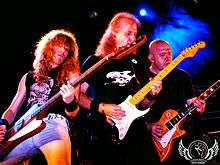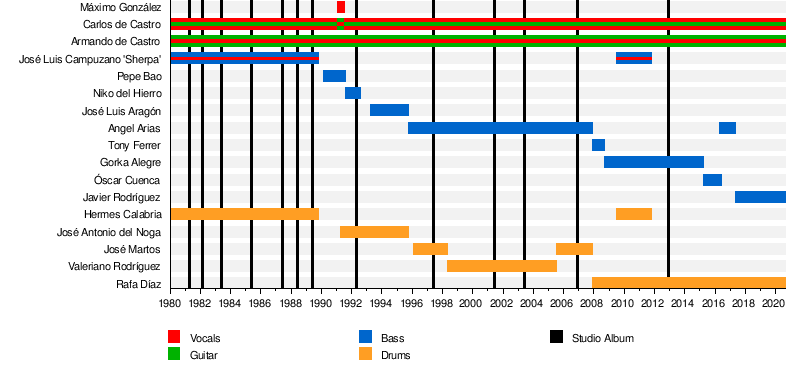Barón Rojo
Barón Rojo (Spanish pronunciation: [baˈɾon ˈroxo]) is a Spanish heavy metal band, who reached international success in the 1980s. The band was led by siblings Carlos and Armando de Castro, previously from the band Coz, and it is considered one of the most important representatives of Spanish hard rock bands. "Barón Rojo" in Spanish is "Red Baron", the name of the band is an homage to Manfred von Richthofen, and the eponymous song "Barón Rojo" is about him.
Barón Rojo | |
|---|---|
 Original line-up of Barón Rojo reunited in 2010. | |
| Background information | |
| Origin | Madrid, Spain |
| Genres | Heavy metal, hard rock |
| Years active | 1980-present |
| Labels | Locomotive Music, Sony BMG, Avispa, Zero |
| Website | www.baronrojo.net |
| Members | Armando de Castro Carlos de Castro Rafa Díaz |
| Past members | José Luis Campuzano "Sherpa" Hermes Calabria Máximo González Pepe Bao José Antonio del Nogal Niko del Hierro José Luis Aragón Valeriano Rodríguez Ángel Arias José Martos Tony Ferrer Gorka Alegre |
They were ranked number 18 on Rolling Stone's "50 Greatest Spanish rock bands".[1]
History
The band released their debut album Larga Vida al Rock and Roll in 1981, and the first single taken from the LP was Con Botas Sucias. It achieved moderate success, earning them several coverage from the media after winning a gold record selling certification.[2] To promote the album, Barón Rojo made a tour around Spain. This first album heavily influenced the Spanish rock band Héroes del Silencio.[3]
They moved to London for the recording of their second album Volumen Brutal (1982) on the Kingsway studios, owned by Deep Purple's frontman Ian Gillan. This album was released in two versions: One with the lyrics in Spanish and another sung in English. Bruce Dickinson from Iron Maiden is credited for helping them with the translation. This led the band to international success specially in England, where they were featured on the cover of music magazine Kerrang!. The album, which included tracks like "Los rockeros van al infierno" ("Rockers Go to Hell", English version), "Incomunicación" ("Isolation Ward", English version), "Concierto para ellos" ("Concert for Them") or "Resistiré" ("Stand Up", English version) sold two million copies worldwide.[4] It is usually considered one of the very best metal albums ever released in Spain, and their best album.[5]
On 27 August 1982 Barón Rojo played at Reading music festival, along with renowned bands as Iron Maiden, Twisted Sister and Marillion.
In 1983 Metalmorfosis, their third studio album also recorded in London, was released and contained, amongst many other tracks, the well-known ballad "Siempre estás allí". Together with Volumen Brutal, it is considered their best album.[6]
After that, they released their fourth studio album En un lugar de la marcha in 1985 with songs as "Hijos de Caín" and "Cuerdas de acero", as well as two live albums titled Barón al Rojo Vivo (1984) and Siempre Estás Allí (1986). Their international tours continued through Europe, Latin America and Japan, playing even with a then young Metallica as their opening band in 1985[7] (the American thrash band, as of 2018, kept on playing live cover versions of Baron Rojo songs[8]).
From then on, the band began experimenting with new elements including orchestral compositions, as it can be heard on their 1987 album Tierra de Nadie, which includes their well-known song "Tierra de nadie". Those first five studio albums are considered Baron Rojo best releases.[9] Meanwhile, the mood between band members, described by them as "pure hatred", kept on getting worse.[10]
By the end of 1989, after they released their albums No va más and Obstinato, bassist/singer/composer José Luis Campuzano “Sherpa” and drummer Hermes Calabria left the band, leaving the De Castro brothers with an ever-changing formation, where components as Pepe Bao (bass) and Maxi González (vocals) stayed in the band for just one year, and Antonio del Nogal "Ramakhan" (drums) stayed for four years.
Desafío, released in 1992 and recorded in Madrid was produced by guitarist Carlos de Castro with Niko del Hierro on bass and José Antonio del Nogal "Ramakhan" playing drums.
After a two compilation albums, the studio album Arma Secreta (1997) and some legal disputes with record company Zafiro about the royalties of the previous albums, BMG released a double compilation album called Cueste lo que cueste, which included 31 hits by the band plus four new songs.
2001 saw the release of the album 20+, an allusion to the more than twenty years of existence of the band, and in 2003 the cover versions album Perversiones saw the light and featured cover versions from bands such as Deep Purple, Black Sabbath, Jimi Hendrix, Janis Joplin and AC/DC.
Drummer Vale Rodríguez left the band in 2005, a place José Martos took again for the second time.
By 2006 the band released Ultimasmentes, in which all the songs were sung by Carlos de Castro, except for the instrumental opening and finale.
Ángel Arias and José Martos left Barón Rojo in 2007, just after the live CD and DVD Desde Barón a Bilbao was released, and Tony Ferrer left the band in September 2008. He was replaced by former Ñu bassist Gorka Alegre.
They made a reunion concert on June 20, 2009 at the Metalway music festival in Zaragoza, with the original formation including José Luís Campuzano "Sherpa" doing vocals. That same year they released their last album yet: live album En Clave de Rock.
After their successful reunion concert at Metalway'09 they reunited again for a tour, starting and finishing in Madrid, with its first concert at "La Riviera" 30 January 2010 and the last at former bullring "Palacio de Vistalegre" 22 October 2011, where they told the concurrence about the filming of a Baron Rojo documentary.[11]
The Barón Rojo film was released in 2012. In 2020 (its 40th anniversary), Barón Rojo was definitely disbanded.[12]
Band members
- Carlos de Castro - vocals, guitar (1980-2020)
- Armando de Castro - guitar, vocals (1980-2020)
- Rafa Díaz - drums (2007-2020)
- Javier Rodríguez - bass (2017-2020)

Past band members
- José Luis Campuzano "Sherpa" - bass, vocals (1980-1989, 2009-2011)
- Hermes Calabria - drums (1980-1989, 2009-2011)
- Máximo González - vocals (1991)
- Pepe Bao - bass (1990-1991)
- José Antonio del Nogal "Kamakhan - drums (1991-1995)
- Niko del Hierro - bass (1991-1992)
- José Luis Aragón - bass (1993-1995)
- Valeriano Rodríguez - drums (1998-2005)
- José Martos - drums (1996-1998, 2005-2007)
- Angel Arias - bass (1995-2007, 2016-2017)
- Tony Ferrer - bass (2007-2008)
- Gorka Alegre - bass (2008-2015)
- Óscar Cuenca - bass (2015-2016)
Timeline

Discography
Studio Albums
- Larga vida al Rock and Roll (1981)
- Volumen brutal (1982)
- Metalmorfosis (1983)
- En un lugar de la marcha (1985)
- Tierra de nadie (1987)
- No va más! (1988)
- Obstinato (1989)
- Desafío (1992)
- Arma secreta (1997)
- 20+ (2001)
- Perversiones (2003)
- Ultimasmentes (2006)
- TommyBarón (2012)
Live Albums
- Barón al rojo vivo (1984)
- Siempre estáis allí (1986)
- Barón en Aqualung (2002)
- Desde Barón a Bilbao (2007)
- En Clave de Rock (2009) (with the Symphonic Band of the CIM of Mislata, Valencia)
Compilations
- Larga vida al Barón (1995)
- Cueste lo que cueste (1999)
- Las aventuras del Barón (2006)
Singles
- "Con botas sucias" ("With Dirty Boots") / "Chica de la ciudad" ("City Girl")
- "Barón rojo" / "Larga vida al rock n roll" ("Long Live Rock n' Roll")
- "Los rockeros van al infierno" ("Rockers Go to Hell") / "Incomunicación" (literally, "Miscommunication", although the song was called "Isolation Ward" in the English language version of "Volumen Brutal")
- "Resistiré" ("I'll Stand Up") / "Hermano del rock & roll" ("Rock n' Roll Brother")
- "Casi me mato" ("I Almost Killed Myself") / "Tierra de vándalos" ("Land of Vandals")
- "Invulnerable" / "Herencia letal" ("Deadly Heritage")
- "El malo" ("The Evil One") / "Rockero indomable" ("Unstoppable Rocker")
- "Campo de concentración" ("Concentration Camp") / "Las flores del mal" ("Flowers of Evil")
- "Concierto para ellos" ("Concert for Them") / "Tierra de vándalos"
- "Breakthoven" / "Chicos del rock" ("Rock Kids")
- "Cuerdas de acero" ("Steel Strings") / "El baile de los malditos" ("Dance of the Damned")
- "Hijos de Caín" ("Sons of Cain") / "Caso perdido" ("Lost Cause")
- "Pico de oro" ("Golden Peak") / "El pedal"
- "Tierra de nadie" ("No Man's Land") / "El precio del futuro" ("The Price of the Future")
- "Travesía urbana" ("Urban Crossing") / "En tinieblas" ("In Darkness")
- "Trampa y cartón" ("Trap and Cardboard") / "Los domingos son muy aburridos" ("Sundays Are So Boring")
- "Get on Your Knees"
- "Alí Baba y los 40" / "Exorcismo" ("Exorcism")
- "Te espero en el infierno" ("I'll See You in Hell")
- "Stand up" / "You're Telling Me" / "Baron Flies over England"
- "Arma secreta" ("Secret Weapon") /"Fugitivo" ("Runaway")
- "Cueste lo que cueste" ("Whatever It Takes") / "Resistiré" (new version)
- "Fronteras" ("Frontiers")
- "Concierto para ellos" (Live) / "20+"(Live)
- "Neon Knights" / "What's Next to the Moon" / "Move over"
Other releases
References
- "Las 50 mejores bandas de rock españolas, según 'Rolling Stone'". Diario El Periódico. (Spanish)
- "Sherpa recibe el disco de oro por Larga vida al Rock n Roll de Barón Rojo 32 años después". manerasdevivir.com. 27 January 2013.(Spanish)
- Aragón, El Periódico de. "Bunbury, en 'Barón Rojo, la película'". El Periódico de Aragón (in Spanish). Retrieved 2019-08-27.
- "Barón Rojo reedita 'Volumen brutal' con motivo del 25 aniversario del grupo". los40.com.(Spanish)
- "Por qué 'Volumen brutal' es la obra maestra del heavy metal español. 35º aniversario". MariskalRock.com (in Spanish). 2017-02-22. Retrieved 2019-08-27.
- Rock (2018-05-16). "35 años de 'Metalmorfosis', la última gran obra de Barón Rojo". MariskalRock.com (in Spanish). Retrieved 2019-08-27.
- "Barón Rojo, en IndyRock". indyrock.es. Retrieved 2019-08-19.
- Press, Europa (2018-02-06). "VÍDEO: Metallica versionan a Barón Rojo en su segundo concierto en Madrid". www.europapress.es. Retrieved 2019-08-19.
- "5 Discos de Barón Rojo que cambiaron el Heavy Metal Español". El Blog Rock&Tipo (in Spanish). 2018-11-12. Retrieved 2019-08-27.
- Marcos, Carlos (2019-04-10). "Barón Rojo: jamás un grupo 'heavy' español tan grande, jamás un final tan triste". El País (in Spanish). ISSN 1134-6582. Retrieved 2019-08-29.
- "Barón Rojo voló sobre Vistalegre". Mariskal Rock. (Spanish)
- Marcos, Carlos (2019-04-10). "Barón Rojo: jamás un grupo 'heavy' español tan grande, jamás un final tan triste". El País (in Spanish). ISSN 1134-6582. Retrieved 2019-08-27.
External links
| Wikimedia Commons has media related to Barón Rojo. |
- Official website
- Armando de Castro's, author, Lead Guitar & singer official website
- Sherpa's,author, original bass & singer official website
- Sherpa's,author, original bass & singer official Youtube channel
- Redbaronfanclub, kerrang's article
- Baron Rojo at Vistalegre 2011 (Spanish)
- Baron Rojo future (Spanish)